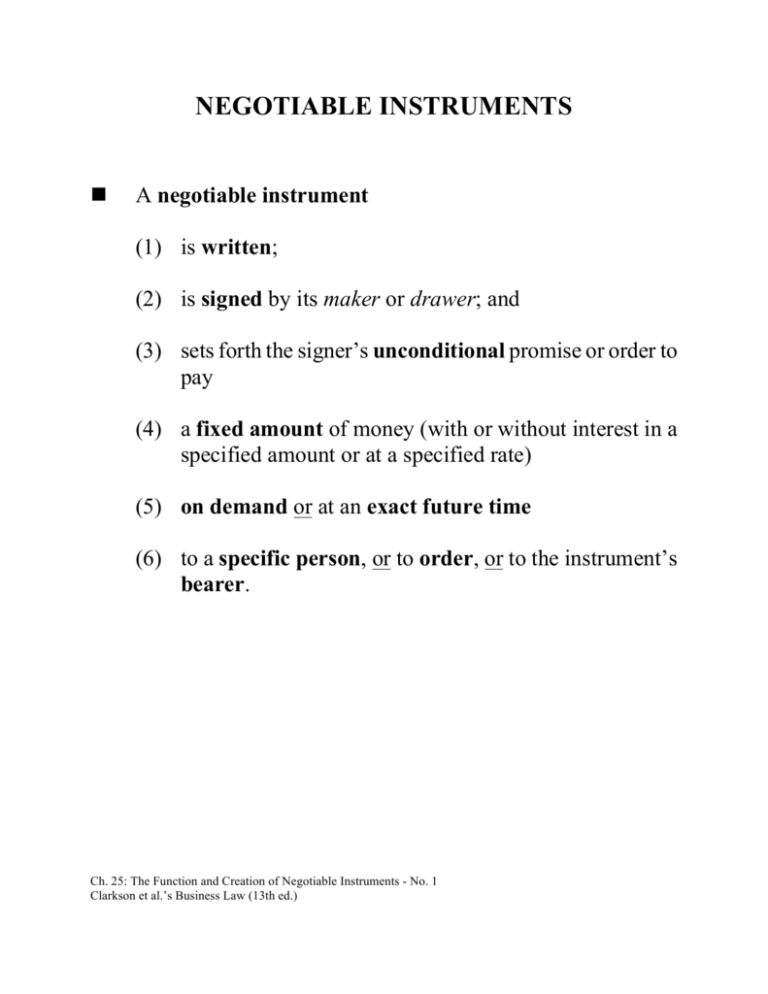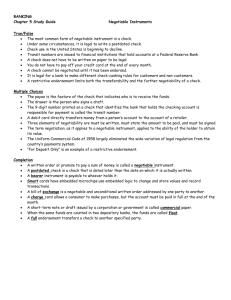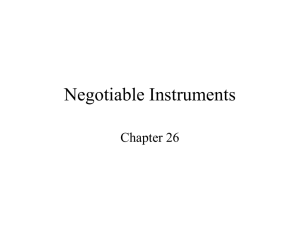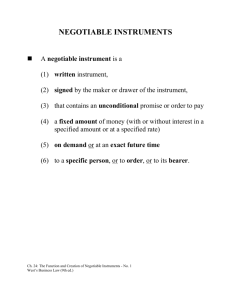NEGOTIABLE INSTRUMENTS
advertisement

NEGOTIABLE INSTRUMENTS n A negotiable instrument (1) is written; (2) is signed by its maker or drawer; and (3) sets forth the signer’s unconditional promise or order to pay (4) a fixed amount of money (with or without interest in a specified amount or at a specified rate) (5) on demand or at an exact future time (6) to a specific person, or to order, or to the instrument’s bearer. Ch. 25: The Function and Creation of Negotiable Instruments - No. 1 Clarkson et al.’s Business Law (13th ed.) TYPES OF NEGOTIABLE INSTRUMENTS n Draft: An unconditional order (including a check) by which the party creating the draft (the drawer) orders another party (the drawee), typically a bank, to pay money to a third party (the payee). n Time Draft: A draft payable at a time certain. n Sight Draft: A draft payable on presentment. n Acceptance: A drawee’s written promise to pay the draft when due or on presentment. A drawee that has so bound itself is an acceptor. n Trade Acceptance: A draft drawn by a seller of goods ordering the buyer to pay a specified sum of money to the seller, usually at a specified future time. The buyer accepts the draft by signing and returning it to the seller. n Promissory Note: A maker’s written promise to pay a fixed sum of money to another person (the payee) on demand or at a specified future time. n Certificate of Deposit: A note by which a bank or similar financial institution acknowledges receiving money from a party and promises to repay the money, plus interest, to the party or the party’s designee, on a certain date. Ch. 25: The Function and Creation of Negotiable Instruments - No. 2 Clarkson et al.’s Business Law (13th ed.) NEGOTIABILITY: WRITING & SIGNATURE n Written Form: A negotiable instrument must be written on material that (1) lends itself to permanence and (2) is portable. n Signature: Any symbol (1) made manually or by means of a device or machine, (2) using any name, including a trade or assumed name, word, mark, or symbol (3) the signer executes or adopts with a present intention to authenticate a writing. n Who must sign? (a) The maker, or her authorized agent, must sign the instrument if it is a note or a certificate of deposit. (b) The drawer, or his authorized agent, must sign the instrument if it is a draft or a check. Ch. 25: The Function and Creation of Negotiable Instruments - No. 3 Clarkson et al.’s Business Law (13th ed.) NEGOTIABILITY: UNCONDITIONALITY n Promise or Order: A negotiable instrument must contain an express order or promise to pay. n n Except in the case of a certificate of deposit, merely acknowledging a debt is not sufficient without evidence that the maker or drawer affirmatively undertakes to repay the debt. Unconditionality of Promise or Order: A promise or order is conditional (and, therefore, not negotiable) if it states (1) an express condition to payment, (2) that the promise or order is subject to or governed by another writing, or (3) that the rights or obligations with respect to the promise or order are stated in another writing. n Merely mentioning another writing does not make a promise or order conditional. Ch. 25: The Function and Creation of Negotiable Instruments - No. 4 Clarkson et al.’s Business Law (13th ed.) NEGOTIABILITY: FIXED AMOUNT n Fixed Amount: An amount (including interest, if any) ascertainable from the face of the instrument – with or without reference to some outside source of information identified on the face of the instrument. n Payable in Money: The amount due must be payable in “a medium of exchange authorized or adopted by a domestic or foreign government as part of its currency.” Ch. 25: The Function and Creation of Negotiable Instruments - No. 5 Clarkson et al.’s Business Law (13th ed.) NEGOTIABILITY: TIME FOR PAYMENT n n Payment on Demand: An instrument is payable on demand, “at sight,” or “upon presentment” if it is subject to payment immediately upon being presented to the payor or drawee. n Presentment occurs when a person entitled to enforce an instrument demands that the payor or drawee pay or accept the instrument. n If no time for payment is specified, a negotiable instrument is presumed to be payable on demand. Payment at a Definite Time: An instrument must be payable (1) on a specified date, (2) within a definite period of time, or (3) on a date or at a time readily ascertainable at the time the promise or order is made. n Acceleration Clause: A clause permitting a payee or other holder of a time instrument to demand payment of the entire amount or balance due, with interest, if a certain event occurs, such as failure to pay an installment when due. n Extension Clause: A clause in a time instrument that permits the date of maturity to be extended. Ch. 25: The Function and Creation of Negotiable Instruments - No. 6 Clarkson et al.’s Business Law (13th ed.) NEGOTIABILITY: PAYMENT TO WHOM n Order Instrument: A negotiable instrument that is payable “to the order of” an identified payee (e.g., “Pay to the Order of Joan Ebert”) or “to” an identified person “or order” (e.g., “Pay to Joan Ebert or Order”). n Bearer Instrument: A negotiable instrument payable “to bearer” or to “cash,” rather than to an identified payee. n Bearer: The person possessing a bearer instrument. n Any instrument payable to the following is a bearer instrument: (1) “Payable to the order of bearer”; (2) “Payable to Jane Smith or bearer”; (3) “Payable to bearer”; (4) “Pay cash”; or (5) “Pay to the order of cash.” Ch. 25: The Function and Creation of Negotiable Instruments - No. 7 Clarkson et al.’s Business Law (13th ed.) FACTORS NOT AFFECTING NEGOTIABILITY n The fact that an instrument is undated does not affect its negotiability, unless the date of the instrument is necessary to understand the payment term. n Antedating or postdating an instrument does not affect its negotiability. n Interlineation, other written or typewritten alterations, and even conflicting terms need not affect negotiability. n Handwritten terms take precedence over typewritten terms, and typewritten terms take precedence over printed terms. n Words take precedence over figures, unless the words are ambiguous in and of themselves. n If the instrument fails to specify the applicable interest rate, the judgment rate of interest (defined by statute) becomes the interest rate on the instrument. n Notations that an instrument is “nonnegotiable” or “not governed by Article 3” do not affect the negotiability of a check but may make other instruments nonnegotiable. Ch. 25: The Function and Creation of Negotiable Instruments - No. 8 Clarkson et al.’s Business Law (13th ed.)











